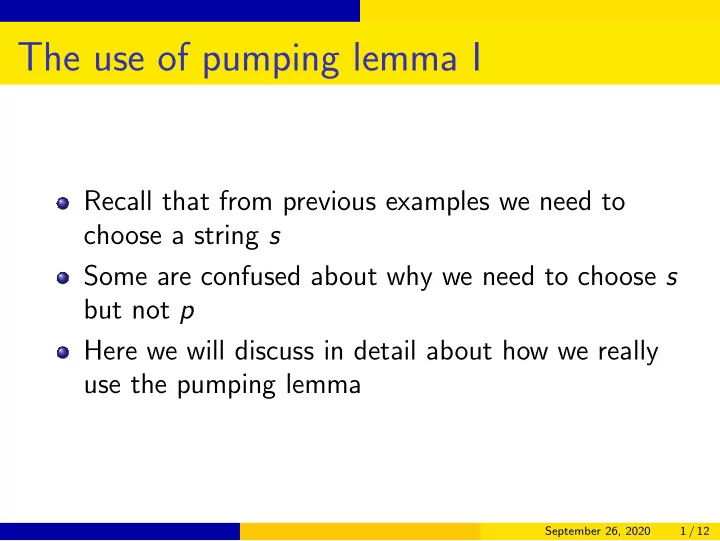

The use of pumping lemma I Recall that from previous examples we need to choose a string s Some are confused about why we need to choose s but not p Here we will discuss in detail about how we really use the pumping lemma September 26, 2020 1 / 12
The use of pumping lemma II Let’s start from the following statement ∀ n , 1 + · · · + n = n ( n + 1) 2 What is the opposite statement? ∃ n such that 1 + · · · + n � = n ( n + 1) 2 Formally, in the pumping lemma regular ⇒ some properties September 26, 2020 2 / 12
The use of pumping lemma III “Some properties” are in fact ∃ p , {∀ s ∈ A , | s | ≥ p [ ∃ x , y , z such that s = xyz and ( xy i z ∈ A , ∀ i ≥ 0 , and | y | > 0 and | xy | ≤ p )] } To do the proof by contradiction, we need the opposite statement of the right-hand side ∀ p , {∃ s ∈ A , | s | ≥ p , [ ∀ x , y , z (opposite of ( s = xyz and ( xy i z ∈ A , ∀ i ≥ 0 , and | y | > 0 and | xy | ≤ p )))] } September 26, 2020 3 / 12
The use of pumping lemma IV What is the opposite of s = xyz and xy i z ∈ A , ∀ i ≥ 0 , and | y | > 0 and | xy | ≤ p ? Various equivalent forms are possible. The one we consider is ( s = xyz and | y | > 0 and | xy | ≤ p ) → ∃ i ≥ 0 , xy i z / ∈ A September 26, 2020 4 / 12
The use of pumping lemma V Therefore, the opposite statement of the right-hand side that we really use is ∀ p , {∃ s ∈ A , | s | ≥ p , [ ∀ x , y , z (( s = xyz and | y | > 0 and | xy | ≤ p ) (1) → ∃ i ≥ 0 , xy i z / ∈ A )] } Note that the opposite of A & B September 26, 2020 5 / 12
The use of pumping lemma VI is A → ¬ B See the truth table A & B ¬ ( A & B ) ¬ B A → ¬ B A B 0 0 0 1 1 1 0 1 0 1 0 1 1 0 0 1 1 1 1 1 1 0 0 0 To prove (1), the “exists” part is important You can see that we need to choose s and find an i September 26, 2020 6 / 12
The use of pumping lemma VII In a sense we guess s or i to see if the statement can be proved. If not, we may try other choices About ∀ x , y , z , · · · in (1) you can see in examples that we go through all possible cases of x , y , z September 26, 2020 7 / 12
Example 1.75 I F = { ww | w ∈ { 0 , 1 } ∗ } not regular We choose s = 0 p 10 p 1 ∈ F If s = xyz , | xy | ≤ p , | y | > 0 , then y = 0 . . . 0 and thus xy 2 z = 0 . . . 010 p 1 � = ww September 26, 2020 8 / 12
Example 1.75 II What if we say there exists i = 3 such that xy i z = xy 3 z = 0 . . . 010 p 1 � = ww ? The proof is still correct. Note that we only need to find an i such that xy i z is not in the language September 26, 2020 9 / 12
Example 1.76 I D = { 1 n 2 | n ≥ 0 } not regular For this language we have n = 0 , 1 0 = ǫ n = 1 , 1 1 = 1 n = 2 , 1 4 = 1111 n = 3 , 1 9 = 111111111 We choose s = 1 p 2 ∈ D September 26, 2020 10 / 12
Example 1.76 II If s = xyz , | xy | ≤ p , | y | > 0 then p 2 < | xy 2 z | ≤ p 2 + p < ( p + 1) 2 and therefore xy 2 z / ∈ D September 26, 2020 11 / 12
Example 1.76 III What if we consider i = 0? It seems that ( p − 1) 2 < p 2 − p ≤ | xy 0 z | < p 2 can also give us xy 0 z not in the language. However, ( p − 1) 2 < p 2 − p may not hold at p = 1. Note that p is any positive integer now However, we still have the proof because as we said, one i is enough September 26, 2020 12 / 12
Recommend
More recommend